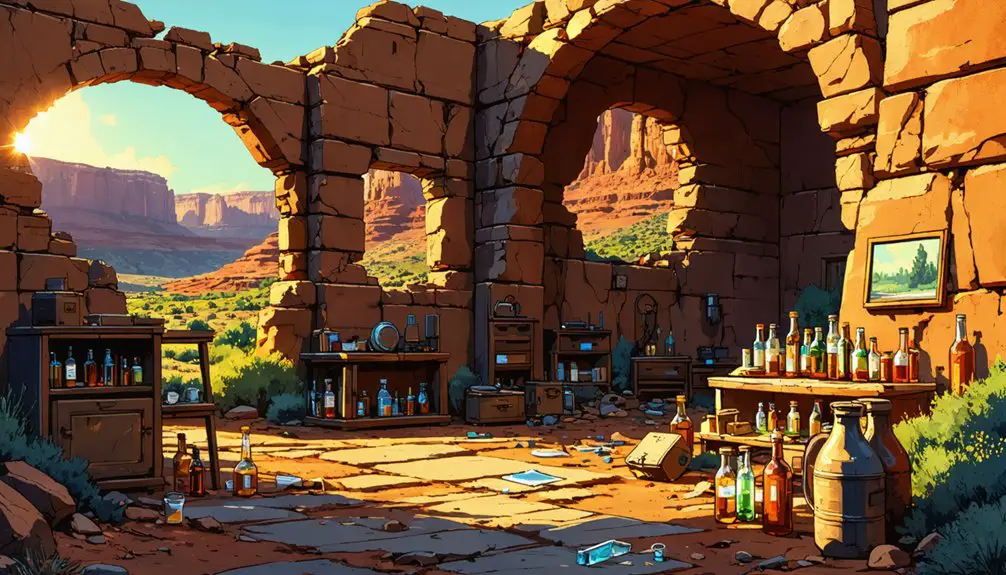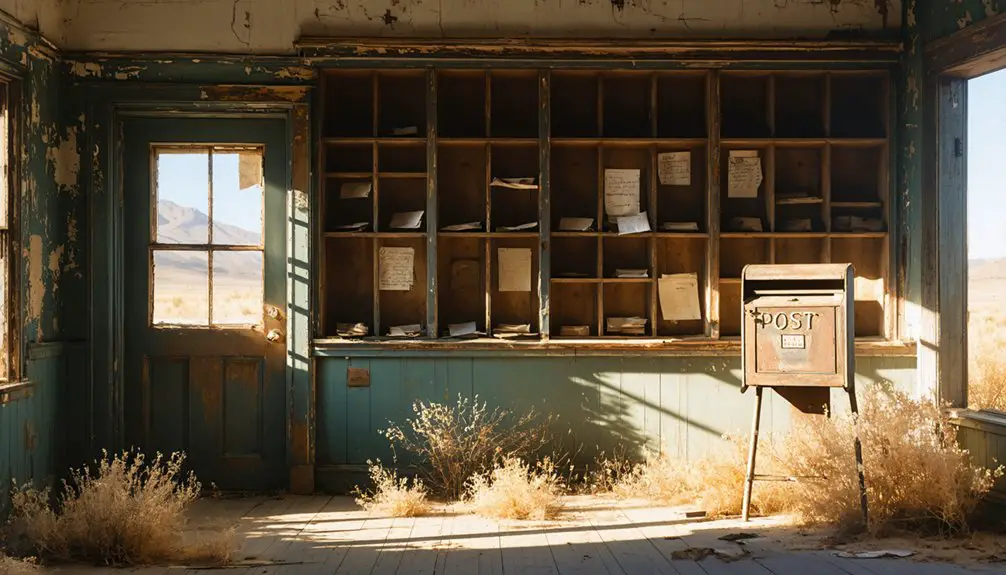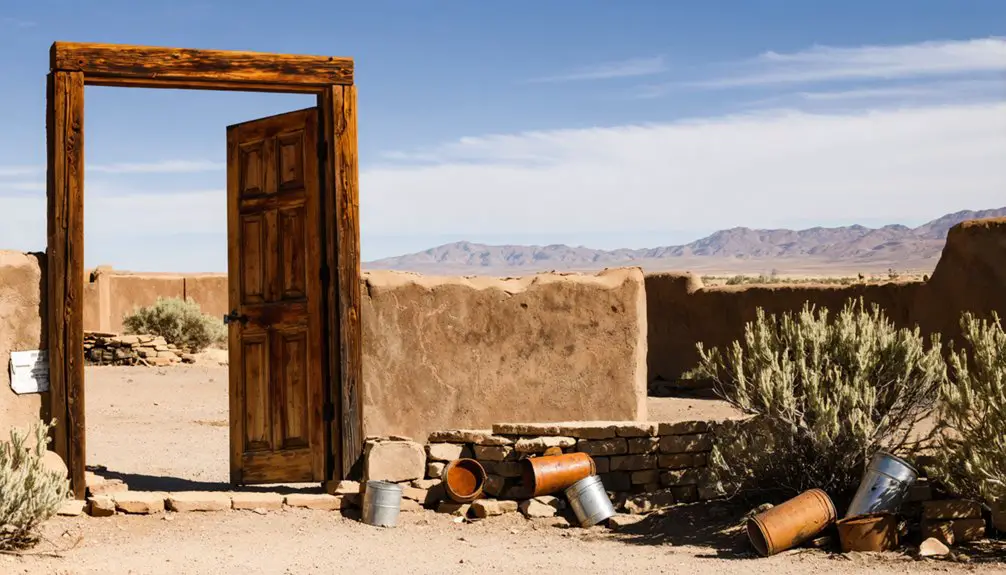You’ll find Richardson’s ghost town remnants in Grand County, Utah, where Dr. Sylvester Richardson established a frontier settlement in 1885 near Professor Creek. He served as the town’s first postmaster, schoolteacher, and merchant, creating a uranium mining community that flourished briefly. Though the post office’s closure in 1905 marked the town’s decline, brick foundations, mining shacks, and archaeological artifacts still tell stories of this ambitious frontier experiment’s diverse population and brief prosperity.
Key Takeaways
- Richardson was founded in 1879 near Professor Creek’s junction with the Colorado River as a mining settlement between Cisco and Moab.
- The town flourished briefly due to uranium mining discoveries in 1898, attracting miners and establishing a vibrant commercial center.
- Sylvester Richardson served as the town’s first postmaster, schoolteacher, and merchant after establishing the post office in 1886.
- Archaeological remains include brick foundations, mining shacks, and artifacts revealing a diverse population, including Chinese settlers.
- The town’s decline began with the post office closure in 1905, leading to rapid abandonment and eventual ghost town status.
The Birth of a Frontier Settlement
When Sylvester Richardson arrived at Bijou Creek in 1885, he laid the foundation for what would become one of Utah’s frontier settlements in Grand County. After facing financial setbacks, he tackled the frontier challenges by constructing a dirt-roofed cabin and later establishing a slab store at the creek’s mouth, which became the town’s commercial center.
The settlement dynamics transformed when Richardson, known as “Professor,” secured a post office in 1886, officially putting the town on the map. The town became an important uranium shipping point by 1898.
You’ll find his influence woven throughout the early community – he served as the first postmaster, schoolteacher, and merchant. Located 27 miles south of Cisco and 17 miles northeast of Moab, Richardson’s strategic position near Professor Creek and the Colorado River shaped its destiny as a waypoint for miners and ranchers. His extensive agricultural experiments yielded a thriving orchard and vineyard that produced almonds, plums, and apricots.
Life in Early Richardson
Although Richardson began as a modest frontier outpost, daily life in the settlement revolved around a bustling mix of mining, trading, and essential services.
You’d find families managing their daily needs through careful resource management, relying on Professor Creek’s waters and nearby timberlands for survival. The discovery of uranium in 1898 transformed the community’s economy, drawing miners and support workers to the area. Like many Utah frontier towns, saloons and gamblers populated the streets during the peak mining years. Summer days were particularly challenging as temperatures often reached above 100 degrees during peak work hours.
Family life centered around the small schoolhouse, where children learned while their parents worked in mines or operated essential businesses.
Education and industry intertwined at Richardson’s schoolhouse, where children studied as parents toiled in mines and local trades.
The post office and general stores served as social hubs, connecting you to the outside world through mail routes and supplies. Despite the town’s isolation, you’d discover a tight-knit community where postmasters, teachers, and miners worked together to sustain their frontier dreams.
Dr. Sylvester Richardson’s Vision

Dr. Sylvester Richardson’s pioneering settlement vision went far beyond his educational background, blending agricultural and mineral resource development to establish a lasting community in Utah’s frontier.
You’ll find his strategic thinking reflected in the precise 160-acre lot allocations he organized for settlers by May 1874, demonstrating methodical planning rather than haphazard expansion. After experiencing several business setbacks in Colorado, including failed ventures in nursery work and cattle ranching, Richardson remained determined to succeed in the American West.
While known for teaching, Richardson’s true legacy lies in his persistent leadership through the founding of a joint stock company and his tireless efforts to transform wilderness into a structured township, despite the harsh environmental challenges that ultimately led to its ghost town status. He and his wife Mary Jane were among the first settlers in the region, arriving in the 1880s to establish their homestead.
Educational Pioneer’s Settlement Dream
Through his ambitious vision in 1873, Sylvester Richardson initiated a unique settlement venture that would combine mineral exploitation, agricultural development, and educational advancement in Utah’s Gunnison Valley.
As both a geologist and educational pioneer, he envisioned communities where cultural growth would flourish alongside resource development.
You’ll find his educational initiatives woven throughout his settlement plans, starting with Richardson’s Colony in 1874.
Despite facing harsh conditions and personal setbacks, including a failed cattle operation and divorce, he persisted in establishing settlements that prioritized community development.
His legacy lives on through Professor Creek, named in his honor, which stands as a reflection of his dedication to knowledge dissemination in frontier territories.
In 1886 he established a new settlement, showcasing his determination to create lasting communities in the region.
Richardson’s approach demonstrated that sustainable frontier settlements required more than just resource extraction.
Like other Mormon settlements of the era, his community relied on the wagon train system for transporting essential supplies and new settlers.
Community Leadership Beyond Teaching
While serving as a frontier educator, Sylvester Richardson expanded his influence far beyond the classroom to become a pivotal community architect in southeastern Utah.
You’ll find his fingerprints on every aspect of early community governance, from establishing the settlement’s first post office to constructing crucial infrastructure that served local farmers, ranchers, and prospectors.
His civic engagement reached new heights when he became a county commissioner after Grand County’s creation in 1890.
Richardson’s entrepreneurial spirit drove him to build a hotel, operate a store, and develop transportation networks including a ferry and toll road by 1902.
Through these initiatives, he created essential supply lines and shaped regional policy decisions.
His leadership transformed a modest settlement into a functioning frontier town with legitimate administrative presence and economic potential.
Despite his ambitious vision, the settlement’s decline became evident when the post office closed in 1905.
Mining and Economic Activities
Once silver veins were discovered in Richardson’s sandstone formations during the late 19th century, the area’s mining operations flourished with a focus on precious metals extraction.
You’ll find evidence of diverse mining techniques, from shaft mining to surface digging along cliffsides, where miners bored tunnels into mountainsides to extract silver, gold, and limited copper deposits. Large tailings piles still mark the locations of substantial ore processing activities. The presence of toxic mineral deposits in these tailings presents environmental concerns today.
The town’s economic fluctuations mirrored the broader regional pattern, with infrastructure including electrical poles, rail systems, and supply routes through Castleton supporting the mining economy.
While Richardson remained small, you can trace its brief prosperity through remnants of mining shacks, processing areas, and the post office that operated until 1905, before the inevitable decline that transformed it into a ghost town.
Mail Service and Community Connection

The establishment of Richardson’s post office in September 1886, with Sylvester Richardson as postmaster, marked a notable advancement in the town’s development beyond its mining operations.
Initially dependent on the Moab trail, you’ll find that mail routes evolved considerably when a shorter path to Cisco opened in 1888, transforming communication efficiency.
Through a network of mail routes connecting Cisco, Moab, Castleton, and Miner’s Basin, Richardson’s post office strengthened community ties until 1905.
You’d see mail carriers traversing challenging terrain by mule and foot, ensuring essential connections between scattered settlements. Mail service facilitated the exchange of newspapers, personal correspondence, and trade information, while Richardson and his wife Marion Muir used these connections to promote agricultural development through their published writings in regional papers.
The Town’s Brief Existence
Founded in 1879 near Professor Creek’s junction with the Colorado River, Richardson emerged as a modest frontier settlement that would prove short-lived in Utah’s history.
Under Dr. Sylvester Richardson’s leadership, the community established a post office and attempted to attract settlers to this remote location between Cisco and Moab.
Despite its brief survival as a uranium shipping point and ranching hub, Richardson’s population never reached substantial numbers.
You’ll find that its fleeting legacy lasted merely 26 years, with the post office’s closure in 1905 marking the beginning of its end.
The town’s inability to sustain economic growth through mining or agriculture led to its swift abandonment.
Today, Richardson stands as a symbol of the challenging nature of frontier settlement, where dreams of prosperity often yielded to harsh reality.
What Remains Today

If you visit Richardson today, you’ll find brick foundations and drainage pipes just below the surface, marking where buildings once stood along the railroad tracks.
The town’s post office building, which operated briefly until 1905, may still be identifiable among the remaining structures.
Mining equipment and ranching artifacts scatter the area, while unmarked graves and soil depressions indicate the location of a small cemetery that served the community.
Physical Site Features
Remnants of Richardson’s once-bustling settlement now dot the Utah landscape, offering visitors glimpses into its frontier past through scattered structural ruins and archaeological discoveries.
You’ll find roofless stone foundations and deteriorating structures standing as silent witnesses to the town’s history, while archaeological findings reveal intimate details of daily life through recovered artifacts.
As you explore the site, you’ll notice imported porcelain pieces and weathered household items emerging from careful excavations, each telling stories of the frontier residents who once called this place home.
Site preservation efforts have documented white-washed floorboards and foundational elements, while the surrounding desert environment has gradually reclaimed portions of the settlement.
Nearby, weathered gravestones in old cemeteries provide additional connections to Richardson’s past inhabitants.
Historical Documentation Evidence
Through meticulous archaeological excavations, historians have uncovered compelling evidence of Richardson’s diverse population and daily life, including Chinese currency, porcelain fragments, and household artifacts that challenge previous historical narratives.
The archaeological findings reveal a more complex social fabric than official records suggest. You’ll find that while written documentation primarily reflects the perspectives of white, literate men, material culture tells a broader story.
Cultural insights from excavated Chinese family homes and businesses along Main Street demonstrate the presence of an underrepresented community. Historic photographs and oral histories from Grand County provide additional context about daily life and economic activities.
The Moab Museum’s “Grand County Ghost Towns” program now preserves these discoveries, ensuring that Richardson’s true diversity and social dynamics aren’t lost to time.
Historical Significance in Grand County
While Richardson’s presence in Grand County may have been modest, its establishment in 1879 marked a significant chapter in the region’s frontier development.
You’ll find Richardson’s story intertwined with the broader narrative of boom-and-bust mining cycles that shaped Utah’s landscape. The town’s role in supporting uranium shipments and facilitating connections between mining communities exemplifies the economic shifts that defined Grand County’s early years.
As one of several small settlements dotting Professor Valley, Richardson contributed to the area’s ranching and mining economy.
Though it never grew beyond a few dozen residents, the town’s strategic location near Professor Creek made it a crucial link in the region’s transportation network.
Today, Richardson stands as a symbol of the resilient spirit of Utah’s frontier settlers and their pursuit of opportunity in challenging terrain.
Frequently Asked Questions
Was Richardson Connected to Any Native American Settlements or Trading Routes?
Like threads in a tapestry, you’ll find Richardson woven into native tribes’ paths along the Virgin River valley, where trade routes once flowed, though no direct trading posts existed there.
What Happened to Dr. Richardson After the Town’s Abandonment?
You won’t find clear records of Dr. Richardson’s fate after the town’s abandonment in 1905. His legacy faded into historical obscurity, leaving no definitive documentation of his later life or death.
Were There Any Notable Crimes or Lawlessness in Richardson?
You won’t find documented crime statistics or law enforcement records for Richardson’s ghost town period. Unlike other Utah mining settlements with notorious incidents, historical archives don’t reveal any significant criminal activity there.
Did Any Significant Natural Disasters Affect Richardson’s Development?
While you might expect dramatic flood history or earthquake impact in such a rugged area, there’s no evidence of any major natural disasters directly affecting Richardson’s development during its brief existence.
Were There Any Churches or Schools Built in Richardson?
You’ll find Richardson had just one small schoolhouse where Sylvester Richardson taught, but no formal church architecture existed. Historical records don’t show any dedicated religious buildings in this frontier settlement.
References
- https://utahstories.com/2023/11/ghost-towns-of-grand-county-utah/
- https://onlineutah.us/richardsonhistory.shtml
- https://moabsunnews.com/2023/10/12/moab-museum-grand-county-ghost-towns/
- https://en.wikipedia.org/wiki/Silver_Reef
- https://www.familysearch.org/en/wiki/Utah_Ghost_Towns
- https://www.canyoncountryzephyr.com/2015/02/02/from-the-zephyr-archives-the-professor-of-professor-valley-by-lloyd-pierson/
- https://bobsblog793.wordpress.com/2017/03/26/a-history-of-yost-utah/
- https://www.youtube.com/watch?v=AoiIha-3iNo
- https://www.ksl.com/article/51362209/how-the-past-lingers-in-these-utah-ghost-towns
- https://www.castlepinesconnection.com/sylvester-richardsons-hard-knock-life/



